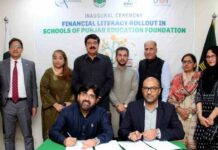Karachi: 16th June, 2021 – The Global Green Finance Leadership Program (GFLP), recently held a webinar on green finance for the Central Asia region, attended by more than 300 participants from central banks, financial regulators, local banks, international organizations (IOs), and research institutions in the region. More than 30 experts from Kazakhstan, Mongolia, Pakistan, China and the UK were convened to share their insights on green investments, green taxonomies, environmental and social risk management, and biodiversity. The event was co-hosted by the Beijing Institute of Finance and Sustainability (BIFS), the Astana International Financial Centre (AIFC), and the Mongolian Sustainable Finance Association (MSFA), with support from the UK PACT program.
This event was a timely response to the many carbon neutrality announcements that developing countries have made recently, such as those along the Belt and Road, like Kazakhstan. It is imperative to examine their current capacity and future needs for achieving these goals. As a network for knowledge sharing and capacity building in green finance, the GFLP looked into this issue and launched the report, Paving the Way for Green Finance Development in Central Asia, which assessed the baseline of green finance progress in the region and developed recommendations for multiple stakeholders to scale-up green investments, including local governments and IOs. The report estimates that significant amounts of green finance and capacity building will be needed to achieve carbon neutrality goals in Central Asia, where economies rely significantly on fossil fuel-related activities and therefore need deep and rapid energy transitions.
Jenny McInnes, Deputy Director of International Climate Finance, UK BEIS said in her opening remarks that, “UK PACT works in partnership with countries to accelerate the global climate transition. We need to raise the ambition and ability of all countries ahead of COP 26”.

In parallel to major announcements on carbon neutrality, major banks and financial institutions operating in the Belt and Road region have signed up to the Green Investment Principles (GIP) for the Belt and Road to improve their capacity for environmental risk management and look for green investment opportunities. During this event, the GIP launched its first regional chapter, chaired by Mr. Yaseen Anwar, the former Governor of the State Bank of Pakistan (SBP), and hosted by AIFC Green Finance Center. The main aim of this regional chapter is to enhance engagement with local stakeholders, identify prospective GIP members and collect green projects to be shared among existing members as potential investments.
Dr Ma Jun, President of the BIFS and Chairman of China Green Finance Committee, stated, “the greening of the global economy requires the greening of every single administration, including the involvement of local institutions of emerging market economies. That gives us our motivation for the launching of this regional chapter”.

“The core function of the chapter is to develop GIP knowledge and activities, build capacity for green and sustainable investment, as well as solve practical problems faced by investors and corporates who wish to make more green investments.” Mr. Yaseen Anwar, Chairman of GIP Central Asia.

Experts from investment institutions in Kazakhstan, Mongolia and the UK shared cases of green investments, specifically promoting green investment with energy transition and infrastructure development. Sima Kamil, Deputy Governor of the SBP emphasized that extensive financial resources would be needed to accelerate sustainability development and that they just launched a national program on environmental and social risk management.
Speakers under the green taxonomies session introduced different major green taxonomies in the world, where Sean Kidney, CEO of the Climate Bonds Initiative, shared the global trends of green taxonomy development. Ms. Raux from UNEP FI presented the results of their internal test application of EU taxonomy and walked through how a taxonomy-aligned loan would be like. Experts from Mongolia and Kazakhstan also introduced their respective green taxonomies and implementation in their domestic markets.
As more and more banks have been aware of the role of Environmental and Social Risk Management (ESRM), Ms. Chuluunkhuu Baartar from Trade and Development Bank of Mongolia explained the bank’s E&S risk assessment process and its integration in the banking system. Ms. Yuan Wei from IFC shared their approach for risk assessment — an ESMS pyramid which emphasized the role of top-down behavioural change from the management, and training and capacity building among the employees, as well as ESG policy and procedures as benchmarks. Bankers from the Development Bank of Kazakhstan assessed the opportunity and risk of renewable energy in the country and their impacts on renewable energy projects.
The topic on the connection between biodiversity and the financial sector has been quite new. Experts from UNEP FI and WWF emphasized the importance of biodiversity and the accelerating crisis in nature by pointing out that the global living planet index reduced 68% from 1970 to 2016. Although biodiversity loss might cause finical risks, as presented by Nick Robins of the London School of Economics and Political Science and the NGFS from the perspective of central banking and financial regulation, nature and biodiversity protection would also create great financial opportunities, e.g. nature-related debt, bonds & funds and other instruments were already found in the market. BIOFIN expert Ainura Shalakhanova from UNDP Kazakhstan argued that financial support for biodiversity in Kazakhstan faced around 50% gap and the solutions for the gap could include ecotourism certification, carbon offsets, etc. (GFLP)





































